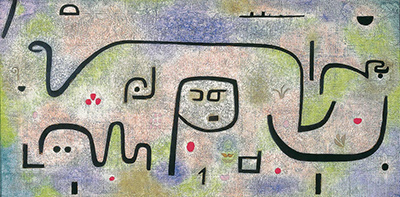The largest painting that Paul Klee created was Insula Dulcamara which was originally named the Island of Calypso.
Colour is very important to Klee's artwork and this is seen in Insula Dulcamara as well. The use of colours of the plants in bloom contrast with the strong black lines. Klee uses shapes and spaces in his artwork. Klee created this piece with newspaper and painted with oil and glue.
The strong line that Klee has painted stretches from the left of the painting to the right and almost represents a serpent. A pale face is seen in the centre of the painting that appears in other artwork Klee has created.
Insula Dulcamara initially refers to the captive stay of Odysseus on the island of Calypso, who was the daughter of Atlas. This point, however, broadened and became more than a mythological painting.
Calypso herself is mostly known for her role in Odyssey. In this tale, she keeps Odysseus to herself on her island in order for him to become her husband. The time Odysseus spent on the island differs depending on which version you read. Calypso manipulates Odysseus with her singing and weaving on her loom. Odysseus falls for Calypso's seduction but soon wishes to return to his wife Penelope.
Athena, Odysseus' patron Goddess, requests that Zeus orders Calypso to release the hero from her island. Hermes is sent to relay this message. Initially, Calypso responds with anger, commenting that gods unfairly despise goddesses having affairs with mortals. Eventually, however, Calypso calms herself and releases Odysseus with wine, bread and resources for him to build his own raft.
Paul Klee would have used this fable to inspire himself initially to create Insula Dulcamara. The patterns and such that he uses on this painting mean different things to different people which is the purpose of art. Some see the painting as a depiction of Klee's dreams and unconscious. Others see Egyptian markings in the symbols and some also see spring in the colour choices that Klee makes.




